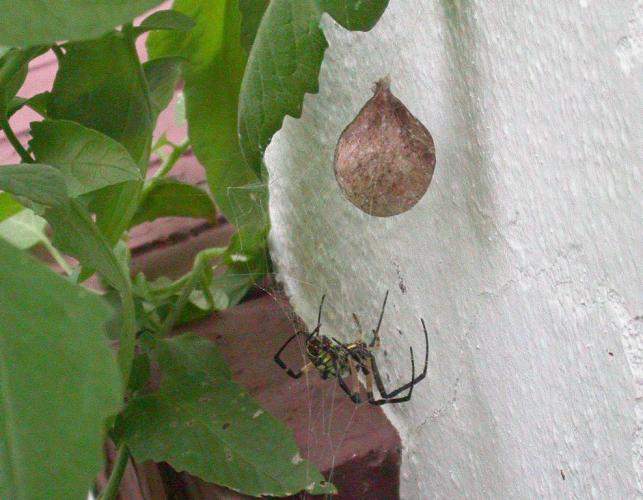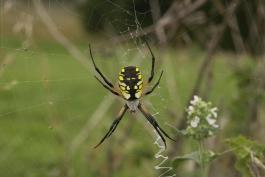
The black-and-yellow garden spider is commonly found near houses and in gardens. The small cephalothorax (head) is tipped with silver hairs, and the slightly oval abdomen is patterned with yellow (sometimes orange) and black. A black midstripe with four white spots in the center marks the top of the abdomen. The legs are black with yellow-orange stripes. The upper portion of the legs is a more solid orange yellow. The circular webs, built only by females, can be approximately 2 feet in diameter, and the spider can be found resting head-down at the hub, where a zigzag silk band, the stabilimentum, extends vertically at the center. Males are quite small and are rarely noticed. Young females have a narrower abdomen, generally lack the yellow coloration, and have conspicuous black and white striping on their legs.
Length (not counting legs): ¾ to 1 inch (females); about ¼ inch (males)

Presumed statewide in tall grasslands with tall herbaceous vegetation as well as in vegetation near homes.
Habitat and Conservation
These spiders build their webs in gardens and in grassy areas near houses. They are also typically found in tall grasslands. Individual spiders take up residence in a particular area and tend to stay there all season. When disturbed, this species often causes its web to vibrate. The bouncing movement and blur makes it harder for predators to get a fix on them. However, if the disturbance is from a trapped insect, the motion causes the prey to get more entangled.
Food
A variety of insects may fall prey to this spider, especially grasshoppers and katydids. Once an insect is caught in the sticky strands of the web, the spider often shakes the web to make the insect more fully ensnared. Then, the spider further subdues its prey by injecting it with venom and wrapping it securely in sheets of silk. Often the spider repairs the damaged parts of its web before turning again to its prey.
Status
Common statewide.
Life Cycle
Young spiderlings hatch in spring and disperse by ballooning on strands of silk that catch the breeze. Once mature, they breed only once, with the much smaller male courting by plucking strands on the female’s web. All summer, the females eat insects and create egg cases that can contain over 1,000 eggs each. The egg cases are a little smaller than ping-pong balls and are papery and tan. Each female can create about 4 egg cases in her life and generally attaches them to nearby plants. After creating an egg case, the female often hides for a few days as she recovers from her efforts. Then, she may return to her old web or create a new one nearby. As temperatures cool in autumn, the female slows and dies in the first frosts.
Human Connections
Black-and-yellow garden spiders help control insect pests and are especially appreciated by gardeners. Also, because of their colorful patterns, tendency to remain in the same general area all summer, remarkable web architecture, and easily observed behaviors, these harmless spiders are excellent creatures for children and adults to watch. If you are frightened by spiders, this is a good one to simply observe all summer to help decrease your phobia. If a female garden spider takes up residence among your tomatoes, try thinking of her as a weird little tenant who pays her rent by gobbling up grasshoppers.
Ecosystem Connections
In addition to their role as predators, these spiders and their egg cases often fall prey to birds, snakes, and even praying mantises. Additionally, certain species of smaller spiders can use black-and-yellow garden spider webs as their own and may feed on the tiny insects caught in the web.

















































